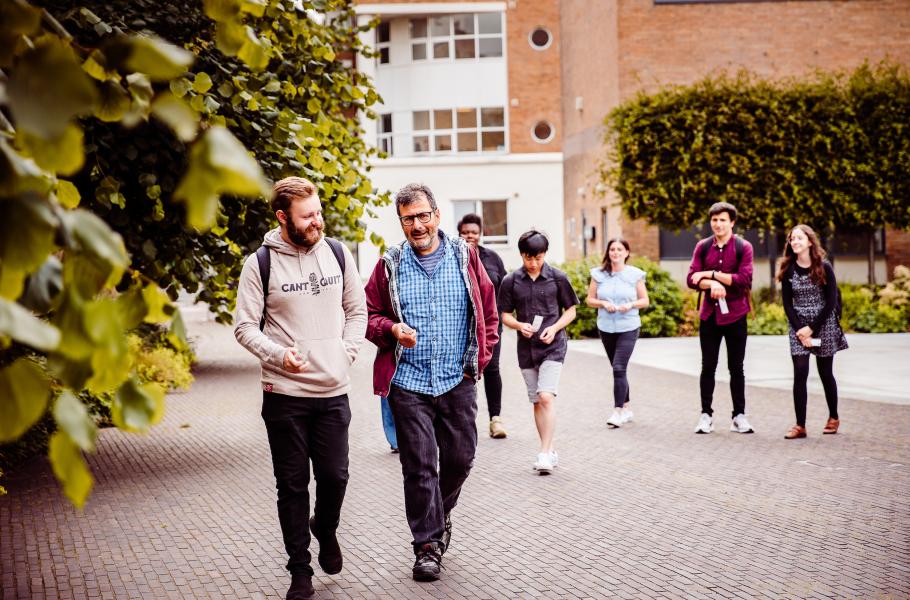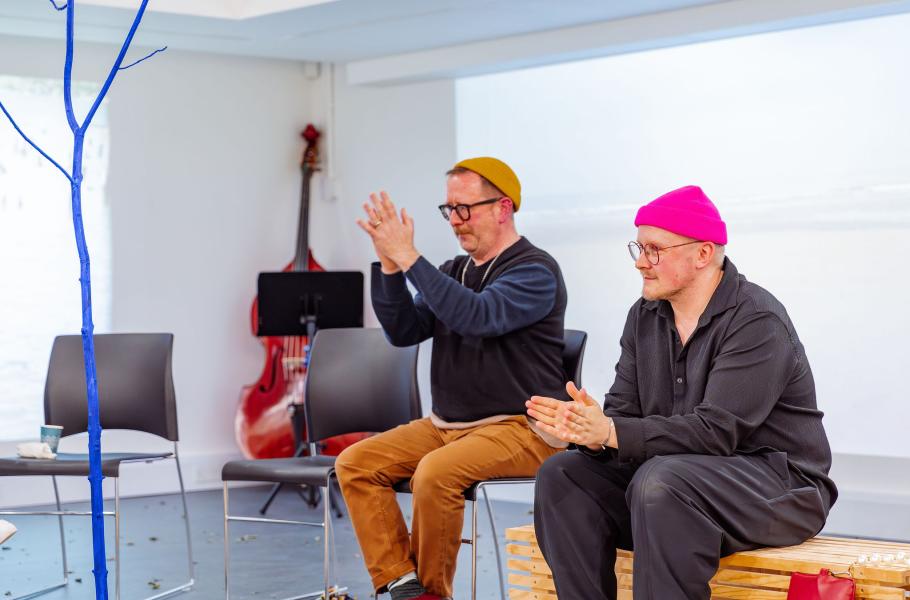Will Dickie: Grief and Place
In January 2023, Will Dickie undertook our Nuffield Residency, a 1-2 week a regular opportunity at Lancaster Arts for an artist or company to test and explore their practice in new ways. Following on and developing our body of work over the last few years on grief and loss, Will spent two weeks with us exploring how ‘place’ can be grieved. Working between the university and a derelict shop in the Mill Race area of Lancaster, he asked: Are there rituals we can undertake for the places we grieve? Can the body be a place that is grieved? How can place and space move us or even ‘sing’ us? Across two weeks, Will explored places in the Mill Race and met local people to investigate these ideas, including locals in an intervention in Lancaster market, a male refugee group (in collaboration with Tara Centre, Lancaster) and the panel members from the Grief, Loss and Place talk (FoSS and LA event in 2022). The residency also engaged three local women artists across three generations, ranging in age from 22 – 67 (and included training/artist development). Will shares some of his thoughts and findings below.
Posted on 1st Nov, 2023
Conversations & Beginnings
This residency has many beginnings.
Summer 2018, walking with Fabiola Santana along the pathways around Lancaster Castle, to and from the River Lune, creating A Walk for Grief. Being in the Church of St Johns the Evangelist, April 2022, and asking visitors to write down the names of places that meant something to them that are no longer there. Gathering in the top of Lancaster Library, last November, to discuss Grief and Place with a group of artists, celebrants, researchers and spiritual practitioners. And then this January 2023, sitting down in a giant room on Lancaster University campus. I begin by catching up with some of those from the library, asking them what remains from our November discussion.
Beginnings beginnings beginnings. But what about the endings?
Talking to Professor Nancy Preston, from the International Observatory on End of Life Care, is another reminder of how easy it is to avoid thinking about the ending. We discuss the struggles people have in talking about and planning the end of their lives, and how place goes with that.
Where do you, or your loved ones, want to be at the end of life? And how can that place be prepared for?
Nancy shares she has seen how at the end of their lives, the world of the person gets smaller and smaller. The places reduce, until eventually they become the last places. The last restaurant they ate at, the last park they walked, the last place they danced. She says ‘you never know the last time you’re going to be in a place.’ I write in my notes that
People are places. People turn spaces into places.
When we miss a place, we miss the other that peopled that space into a place.
Dr Elham Kashefi, director of the Tara Centre, tells me how listening to ‘the other’ has guided her in her workplace. At its current location by Lancaster Castle (look for the heart in the window) Elham and her colleagues took time to slow down and listen to their place. Elham says that a place is full of past energies of what went before, morphic resonances. Over years now, she has been in a dialogue with the place. Asking it questions, blessing its transitions, and letting it sing.
How do you let a place sing you?
How do you let a place move you?
Not moving, but being moved.
Listening first, and then being moved by what you hear.
Elham points out how a consumerist point of view treats places as there for the taking. ‘What can I get from this place?’ I wonder how much this way of thinking has lead to our planet’s current condition. How different would things be if we treated places as if we could hear them? How many shiny new buildings & constructions are grieving, in secret, for the land they now stand on?
I end by discussing this with celebrant and artist Mia Wilson. She tells me about the grief she has for the local theatre where she grew up. Corporatisation changed the nature of the community there. She described it as ‘a gradual goodbye before you knew you were saying it.’ I wonder how many places leave us like that.

I’m an artist - I have a question to ask you about place
I clear away the ice from the stone centre piece in market square, setting up my A-board on the main thoroughfare.
I put out 2 cushions and take a seat,
holding an empty space between my palms.
I listen to the trader at the curry stand’s gentle call:
‘Pakoras, Bhajis now only £1. If you take them home then I can go home.’
Someone points out a pigeon that is ice skating.
I’m convinced it is definitely not the most appealing time for folks to risk sitting with a stranger.
And yet in 2 hours I have 7 conversations, maybe more.
There’s even a queue at one point. How British.
I also have a hug, a selfie and am told that I made someone’s day.
Our collection continues to grow.
A collection of places that meant something, that are no longer there.
Patterns are emerging:
Homes & Family places
Education places
Fun places
and places to experience the more than human…

The old shop
With our collection in hand, I and four other explorers (Gwen Atkinson, Julie Meyfroidt, Lina Yordanova & Fabiola Santana) enter this space in the Mill Race area of Lancaster city centre.
What was a barbers is now this. I hesitate to label it. An empty shop? An old barbers? A retail opportunity? Or still ‘Off your Head’?

Once inside we spend time slowing down. I ask the group to listen to the space, and let it move them. They are brave. It’s cold. And dusty. The junk mail is piling up, as are the dead flies on the window ledges. Gwen points out the flies have taken different death poses and ponders how each one came to be. The mirrors of the barbers have been removed, leaving twisty blobs of grey glue on the wall. Gwen begins to channel their patterning with delicate finger movements and swirling breath sounds. We watch with interest as her aversion to the space is transformed through these actions. She tells us she is seeing beneath the surface of appearances. I am amazed that the wall where the mirror used to be is continuing to reflect parts of us back to ourselves. Lena, Fabiola and I find corners of the space that house our bodies in ways they weren’t designed for. Amidst the dereliction, the rules of the space can been played with and changed. It feels like now the space is empty, it welcomes our bodies and their movements. We fill the voids in new ways, looking for new meanings. Like Gwen, we are moving beyond surfaces to see what dances beneath them.



After making her initial physical responses Julie shared with us a web of connections she has made. Her current work (also with the Tara Centre) is with young men seeking asylum who are living locally in hotels. She tells us about an Iranian man who arrived in the UK with his barber’s kit and high aspirations of continuing that work here. During his ongoing application process she noticed how those aspirations faded. She pointed out the circle of cracked glass in the barber shop door, and explained that, for a moment, she imagined it as a bullet hole. Her score ends by moving with cobwebs attached to her fingertips. She tells us that each time we break a spider’s web, it’s as if their body has had a stroke. So connected are they to their places.

Structure & Gratitude

Here is the ritual structure we put on the wall. At the offering stage, we sung and spoke our collection of grief places into the space. Its a tantalising first go and a new area of my practice seems to open up. And I’m back with Elham, asking how the space would like to be sung. I’ve been reading a book called Ritual Music and Hindu Rituals of Kerala. Much of my understanding of ritual comes from my field research of the traditional arts and martial art practices of Kerala, South India. In the book, the structure of the ritual music and actions are described as devotional, designed to ‘please the deity and in return receive her blessings’. I wonder if it is possible to design an art experience that pleases a neglected space? And in so doing, what blessings would those who are there receive?
Neglected Spaces.
Neglected People.
Neglected Endings.
Blessed Spaces.
Blessed People.
Blessed Endings.
Thank you old shop, for keeping us dry. For helping us hear one other. For shielding us from the Lancaster one way system. For giving us a chance to try this all out.
www.willdickie.co.uk





